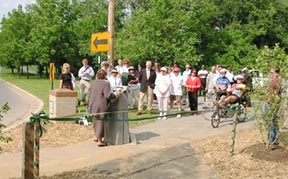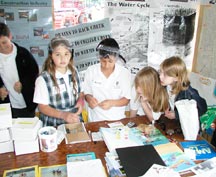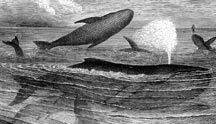|
Dock of the Bay
New Toes in the Patuxent
Gov. Ehrlich wades in with Bernie Fowler

June 8 at 1:55pm–The rain holds off as police and security guards make sure the gathering in the wet field next to the Patuxent River is safe — if not dry — for Maryland Gov. Bob Ehrlich. Wade-in leader Bernie Fowler sits to slip on his now-famous 16-year-old sneakers.
 |
photos by Sara Ebenrich
Wading into the river, from right to left: State Sen. Roy Dyson, Gov. Robert Ehrlich, former Sen. Bernie Fowler, his grandson, daughter and a friend. |
2:05pm–Gov. Ehrlich strides from his car across the field toward Bernie Fowler and State Sen. Roy Dyson. Shaking hands, Dyson notes that he’s never missed a Patuxent River Wade-in. “You’re going to make a pledge never to miss one either,” he says to Ehrlich.
“That’s a good idea,” Ehrlich replies. By the time he reaches the podium, the governor is ready to announce: “I’ll commit to being here every year.”
It’s a first: A Maryland governor drove south to join the wade-in that has made the pages of national and international news and has been a visual centerpiece of nearly every television program on the Bay since the late 1980s. This is the wade-in that has inspired folk on other Maryland rivers to begin their own annual June river rituals.
2:25pm–Republican governor Ehrlich joins hands with two Democrats — former senator Bernie Fowler and current senator Dyson — and St. Mary’s Republican County Commissioner Tom McKay for the 16th annual Patuxent River Wade-in at Broomes Island in Calvert County.
At about 2:30pm, when the waders are knee-deep into the river, Bernie Fowler declares that he can no longer see his sneakers.
That’s the famous ‘sneaker test’ for water quality. This year’s measurement is a big drop in depth from most of the last 10 years, when waders sometimes got waist-deep. The culprit, most say, is soil washed off fields by the heavy rains.
 |
| St. Leonard School third graders watch release of 4 to 5" turtles in the murky water of the Patuxent. |
When third graders at St. Leonard School in Calvert release baby terrapins, it’s hard to see the turtles swimming out even in ankle-deep water.
Still, there is good news. Fowler happily points to the fact that underwater grasses are coming back in that section of the Patuxent for the first time in decades.
And Maryland’s new governor, whose environmental commitment has been questioned, echoes Fowler in describing clean air and water as a deep human need. “The Bay is our environmental and economic future,” Ehrlich said. “You can’t divorce the two.” Erhlich reiterated his commitment to upgrade sewage plants state-wide, saying it will take a billion dollars before that is completed.
Keep tuned. A wade-in is a symbolic ritual, helpful for raising consciousness. Now that money is tight, we’ll see if raised consciousness translates to cleaner water.
— Sara Ebenreck
to the top
1,500 Feet to Go
Annapolis’ Poplar Trail just got a little longer
You’ll have to excuse city of Annapolis trails director Steve Carr if he seems a little overenthusiastic about the new 1,500-foot-long, six-foot-wide section of the Poplar Trail he dedicated last Thursday. To him, the new pathway is more than just a glorified sidewalk; it’s the culmination of more than two years and $60,000 worth of effort to create a safe place for people to congregate and recreate.
“If you stand on this trail for any time at all, what you see is all sorts of people — black, white, young, old, rich, poor, people on bikes, people pushing baby strollers and people walking their dogs,” Carr declared. Plus, it’s a safe way for the schoolchildren to get back and forth to [Germantown Elementary] school
A glance down the walkway’s park-like corridor corroborated Carr’s description. So why was blazing the trail from Windell Avenue to Admiral Drive such a difficult proposition?
The answer lies in a familiar refrain in local politics: limited funds, government bureaucracy and community conflict.
A state Program Open Space grant funded half the extension’s cost, but Carr had to dip into city coffers for the remainder, which meant wading through the months-long municipal budget process. Then, he had to find an architect who could design a pleasant-looking lane that navigated a continuous line of utility poles and numerous storm drain gutters.
Overcoming those challenges was like a Sunday stroll, however, when compared to negotiating easement and right-of-way issues with local businesses. Ward 3 Alderwoman Classie Hoyle — whose district encompasses the trail — had to negotiate with a West Street car dealership that didn’t want just anyone hanging out at its back door.
“They did not want to move,” Hoyle said. “But we kept telling them how great this project was and they said, ‘Okay, Classie, if you say so.’”
The journey took its next unexpectedly sharp turn when the county school board threatened to cut off bus service to local residents if the trail was built.
“The school board said ‘if there is a continuous sidewalk to a residential area that was within a half-mile of a school, it’s our right to discontinue bus service.’ “That sunk it for a year right there,” Carr explained.
All of which left him wondering if this 1,500 feet of trail would ever get built.
Many months and several community meetings later, the issues were resolved. Then Carr had to hire a contractor, who had to find a day or two when it wasn’t pouring rain so that the work could get done.
But last Thursday, under suddenly sunny skies, all of that seemed a distant memory as Carr, Hoyle, Annapolis Mayor Ellen Moyer and Parks and Recreation director LeeAnn Plumer joined a dozen walkers and bicyclists of all ages to christen the new path.
 |
photo by Steve Carr
Annapolis Mayor Ellen Moyer dedicates a new, 1,500-foot section of Poplar Trail, which runs along an old railroad right-of-way behind Germantown Elementary. |
“This city is a network of trails,” Mayor Moyer announced proudly before taking the first steps on the new strip. “And we’re not finished.”
Carr promised the Poplar Trail’s final phase will connect Admiral Drive to Jennifer Road and the county’s trail system. On the other end, at Taylor Avenue, the city plans to eventually link up to the Academy Trail and the B&A Trail. Construction on both projects is at least a year away. Maybe more if this example holds.
Until then, folks seem to be satisfied with what they’ve got.
“The city of Annapolis is pretty friendly on trails. They’ve done great.” said Peter Olsen, executive director of One Less Car, a statewide group that campaigns for more biking and walking trails, before he tried out the new strip.
Mike Vore of the Annapolis Bike Club was also eager to get started: “I’m gonna explore a little piece that goes by the police station. Looks like something goes that way,” he said. “I’m gonna find out.”
— Gary Starikoff
to the top
Water, Water Everywhere
What comes down makes trouble all around
It’s raining and that’s bad. Ms. Lobe’s fourth-grade science class at the Annapolis Public Works Expo is dry under tents. It’s Back Creek they’re worried about. They’ve been testing the water’s chemical content for the past half-year. Rain, they explain, causes runoff of chemicals into the creek. And chemicals in the creek mean chemicals in the Bay.
 |
photos by Eric Smith
Fourth graders from St. Anne’s Day School, armed with test tubes and color charts supplied by Chesapeake Bay Foundation, monitored creeks that flow into the Bay. |
The Chesapeake Bay Foundation armed Lobe’s fourth graders from St. Anne’s Day School and other science classes in the area with test tubes and color charts to monitor creeks that flow into the Bay. Now the class has come to Expo to run a booth about what they’ve been doing, and what they found.
“Phosphate levels have generally gone up,” Lobe says. Their last reading results support this. Phosphate is high; 2ppms [parts per million] out of 5 on the chart. “Back Creek is right near a water treatment plant,” Lobe explains. “That has a lot to do with it. And there’s that new retirement home going in there. That will probably contribute to pollution, too.”
On a brighter note, “chloride has gotten better,” Lauren Bosma says.
 Why are phosphates bad? Why are phosphates bad?
“Algae,” someone responds. “Algae blocks the sun, so the plants die. If plants die, fish don’t have anything to eat.”
Nitrates are a problem partner. They get in the water, Katie Kennedy says, “by people littering.”
The booth hums with scientific activity; test tubes whiz back and forth, water is poured, tubes shaken. Students brought creek water to test for copper, chlorine, phosphates, iron and dissolved oxygen. Only when classmate Nia Adee sings “I Will Survive” on the karaoke machine do the young scientists look up from their work.
By the time Nia returns to the booth, the copper test is done; according to the color chart, it’s about .75ppms.
Other readings come up. Dissolved oxygen, the good guy, is only at 4ppms out of a possible 8. Chloride, happily, comes up at zero.
Still, phosphate levels are worrying. And these kids aren’t willing to sit in a classroom and watch the ecosystem die. Last Monday they took change into their own hands, waded into the water and planted sea grasses they had been growing in their classrooms.
“It was freezing,” Katie says.
“You need more plants to give off oxygen,” Nia, the singer, explains.
Oxygen is important for everyone in the food chain. Aquatic plants also calm the water. Less churning means less mud in the water and more sunlight. More sunlight, more plants. So when plants die, it’s hard to grow new ones. But once the process is started, it gets easier and easier.
Most of the readings are done and it’s almost time to go. This school’s half-hour shift at the booth is over. Other science classes from other schools will soon show up and take over.
This is what they’ve done. What can we do?
“You can help the Bay by not dumping your garbage in it,” Lauren says, “When we went to plant our plants, we saw a butter box in the water. That kind of thing’s not good,”
Ms. Lobe gathers her students. Test tubes go back in their boxes. A few workers at the Expo take a turn at karaoke. It’s still raining. Annapolis Mayor Ellen Moyer says a few words and mentions this weather pattern is part of a 20-year trend. “So get used to it,” she says.
More runoff.
As the kids leave, they don’t take their kits with them. But they take what they’ve learned: that human expansion can cripple a delicate ecosystem. Their knowledge is an antidote to an otherwise rainy future.
— Eric Smith
to the top
Way Downstream …
In Annapolis, dismissal this week of the top two officials in the Office of Smart Growth has raised concerns about Gov. Robert Ehrlich’s commitment to the slow-growth policies of Parris Glendening. John Frece, a former Baltimore Sun reporter who was acting head of the office, told his old paper he worried that Ehrlich considered Smart Growth as an old Glendening program …
In New York, a new study by the environmental group INFORM has documented startling facts about cell phones. The report said that over 100 million Americans use cell phones and that over the next several years, 130 million of them — including batteries and chargers — will be discarded each year, adding up to an additional 65,000 tons of garbage. Because all that wireless waste leads to chemical contamination, INFORM recommends cell phone recycling programs and mentions Verizon as a company to contact …
In Brazil, the new left-leaning government of President Lula da Silva has angered the timber industry with new rules on cutting down mahogany trees in the Amazon. The price of mahogany already has soared in global markets and may go even higher now because of the new rules in Brazil, which produces half the world’s supply …
 Our Creature Feature comes from Virginia, where a dead 30-foot-long humpback whale was found floating in the Bay last week and towed to the First Landing State Park in Virginia Beach. Joan Barns, public relations coordinator for Virginia Marine Science Museum, told Bay Weekly that the carcass had both new and old entanglement marks and other wounds. Our Creature Feature comes from Virginia, where a dead 30-foot-long humpback whale was found floating in the Bay last week and towed to the First Landing State Park in Virginia Beach. Joan Barns, public relations coordinator for Virginia Marine Science Museum, told Bay Weekly that the carcass had both new and old entanglement marks and other wounds.
“The animal’s jaw had a severe break in it, which was indicative of a boat strike,” Barns said. “What we don’t know was whether that boat strike happened before the animal died or after, and we won’t know for some time.”
to the top
|
|